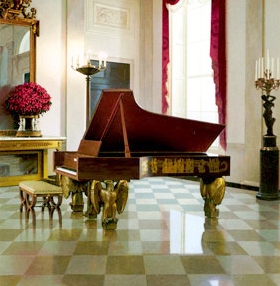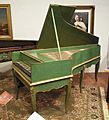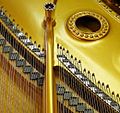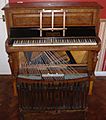Piano facts for kids
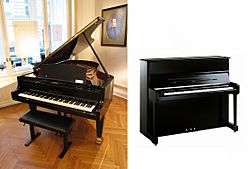
A grand piano (left) and an upright piano (right)
|
|
| Keyboard instrument | |
|---|---|
| Hornbostel–Sachs classification | 314.122-4-8 (Simple chordophone with keyboard sounded by hammers) |
| Inventor(s) | Bartolomeo Cristofori |
| Developed | Early 18th century |
| Playing range | |
The piano, also called a pianoforte, is a musical instrument with a keyboard. Most pianos have 88 keys. When you press a key, a small hammer hits strings inside the piano. This makes a sound.
Pianos come in two main types: grand pianos and upright pianos. The piano has been very popular in Western classical music since the late 1700s. A person who plays the piano is called a pianist.
Contents
Piano History
The piano was invented by Bartolomeo Cristofori from Padua, Italy. He made his first piano in 1709. The piano grew out of an older instrument called the clavichord. A clavichord looks like a piano, but its strings are hit by a small metal blade. In a piano, the strings are hit by a wooden hammer.
Older keyboard instruments like clavichords, harpsichords, and organs had fewer keys. Over time, the keyboard grew longer. Today's pianos have 88 notes, which is seven octaves plus three extra notes.

The upright piano was invented in 1800 by John Isaac Hawkings. Seven years later, T. Southwell invented "overstringing." This means the strings for low notes cross the soundboard diagonally. This makes them longer and creates a much bigger sound.
In 1825, the cast-iron frame was invented in America. This made the piano much stronger. It allowed the piano to make a louder sound, and the strings were less likely to break.
Parts of a Piano
A piano has a keyboard with white and black keys. When you press a key, a part called a damper lifts off the string. Then, a hammer quickly hits the string and bounces off. This allows the string to vibrate and make a sound. When you lift your finger, the damper falls back onto the string, and the sound stops.
The strings are stretched very tightly across the piano's frame. They pass over a bridge, which touches the soundboard. The soundboard is very important because it helps send the vibrations to make the sound louder. If the soundboard is damaged, the piano won't make a sound.
The part that makes the hammer bounce off the string quickly is called the "escapement." In 1821, Sebastian Erard invented a special double escapement. This made it possible to play the same note very quickly. The hammers are covered with felt, which is made from wool, silk, and hair.
Piano Pedals
Most pianos have two pedals. Larger pianos often have three.
- The damper pedal is on the right. When you press it with your right foot, any notes you play will keep sounding. This happens even after you lift your fingers from the keys. This is because the dampers, which usually rest on the strings, lift up. This allows all the strings to vibrate. When a note is played, it continues to sound. Other strings might also vibrate slightly, which is called "sympathetic vibration." This makes the sound smoother and richer. Pianists learn how to use this pedal well.
- The soft pedal is on the left. When you press it with your left foot, the notes sound quieter. On a grand piano, the whole keyboard and hammer system shifts slightly to the left. This makes the hammers hit only two strings instead of three. Also, the parts of the felt that hit the strings are softer. This pedal is sometimes called the una corda pedal, which means "one string."
- The middle pedal is called the sostenuto pedal. Like the damper pedal, it keeps the sound going. However, it only affects notes that are already being played when you press the pedal. This lets you hold one chord while playing other notes that won't keep sounding. Most concert grand pianos have a sostenuto pedal. Some upright pianos also have one.
Some upright pianos have a middle pedal that is a practice pedal. This pedal puts a piece of cloth in front of the strings. It makes the sound very quiet so a pianist can practice without bothering others.
Famous Piano Composers
Once the piano became popular in the late 1700s, many composers wrote music for it. Wolfgang Amadeus Mozart first learned on harpsichords. But the piano became popular when he was young, and he wrote many pieces for it. Franz Joseph Haydn also wrote a lot of piano music.
Ludwig van Beethoven was a famous pianist before he became a famous composer. His piano works include 5 concertos and 32 sonatas. In the Romantic period, many composers wrote for the piano. These include Franz Schubert, Robert Schumann, Johannes Brahms, Franz Liszt, and Frédéric Chopin. Later composers include Sergei Rachmaninoff, Claude Debussy, Maurice Ravel, Sergei Prokofiev, Dmitri Shostakovich, and Béla Bartók.
Famous Piano Players
Some famous piano players from the early days include Jan Ladislav Dussek, Wolfgang Amadeus Mozart, Muzio Clementi, John Field, and Frédéric Chopin. In the 1800s, Franz Liszt greatly influenced piano playing. He composed and performed very difficult music. Other great pianists were Clara Schumann and Anton Rubinstein.
20th-century pianists include Artur Schnabel, Vladimir Horowitz, Josef Hofmann, Wilhelm Kempff, Dinu Lipati, Claudio Arrau, Artur Rubinstein, Sviatoslav Richter, and Alfred Brendel. Today, some of the greatest pianists are Vladimir Ashkenazy, Daniel Barenboim, Leif Ove Andsnes, Boris Berezovsky, and Evgeny Kissin.
Pianists who play popular music include Liberace, Jerry Lee Lewis, Little Richard, Elton John, Billy Joel, Thelonious Monk, Tori Amos, and Ray Charles. One of the greatest jazz pianists was Fats Waller.
Playing the Piano
The piano has been a very popular instrument since the mid-1700s. It quickly took the place of the clavichord and harpsichord. By the early 1800s, the piano's sound was loud enough for large concert halls. Smaller pianos were made for homes. Upright pianos became popular for home use.
Pianos are not often used in orchestras. If they are, they are part of the percussion section. However, they are used for piano concertos, which are pieces for a solo pianist with an orchestra. There is a huge amount of music written just for solo piano. The piano can also be used with other instruments, in jazz groups, and for accompanying singers.
Piano Keyboard
In the past, piano keys were often made from sugar pine. Today, they are usually made of spruce or basswood. Spruce is often used in high-quality pianos. Black keys were traditionally made of ebony. White keys were covered with strips of ivory. However, because ivory-producing animals are now endangered, most makers use plastics.
Almost every modern piano has 52 white keys and 36 black keys, making 88 keys in total. This covers seven octaves plus a minor third. Many older pianos only had 85 keys. Some piano makers have added more keys. For example, the Imperial Bösendorfer has nine extra keys at the low end, making 97 keys. These extra keys are sometimes hidden under a small lid. More recently, the Australian company Stuart & Sons made a piano with 108 keys.
These extra keys are mainly added to make the sound richer. They vibrate with other strings when the damper pedal is pressed. Only a few pieces of music actually use these extra notes.
Toy piano companies like Schoenhut make smaller pianos with 44 or 49 keys. These are real pianos with working parts and strings.
Playing Techniques
Like other musical instruments, the piano can be played from written music, by ear, or by making up music on the spot. Some folk and blues pianists taught themselves. But in classical and jazz music, there are well-known teaching systems. These include graded exams and university degrees in piano.
Piano playing techniques changed as instruments developed from the harpsichord to the modern piano. Changes in music styles and the rise of amazing performers also helped these techniques grow. While technique is about how you physically play, many teachers say it's also connected to your mind and feelings. Famous approaches to piano technique include those by Dorothy Taubman and Charles-Louis Hanon.
Types of Pianos
Modern pianos come in two main shapes: the grand piano and the upright piano. There are also special pianos, electric pianos, electronic pianos, and digital pianos. Electric pianos use electromechanical designs. Electronic pianos create piano-like sounds using electronic parts. Digital pianos use digital samples of real piano sounds.
Grand Pianos
In grand pianos, the frame and strings are flat, or horizontal. The strings stretch away from the keyboard. Grand pianos can be from about 1.5 meters (5 feet) to 3 meters (10 feet) long.
- Baby grand – around 1.5 meters (5 feet)
- Parlor grand or boudoir grand – 1.7 to 2.2 meters (5.5 to 7 feet)
- Concert grand – between 2.2 and 3 meters (7 to 10 feet)
Generally, longer pianos with longer strings have a bigger, richer sound. Smaller grand pianos fit better in homes and cost less. They are also used in small teaching studios.
Upright Pianos
Upright pianos, also called vertical pianos, are more compact. This is because their frame and strings stand up vertically. The upright piano's action was invented in London in 1826 by Robert Wornum. Upright pianos became the most popular type for home use. They take up less space than grand pianos.
The hammers in an upright piano move horizontally. Upright pianos are usually less expensive than grand pianos. They are widely used in churches, community centers, schools, and music programs. They are popular for practice and home use.
Special Pianos
- A toy piano is a small piano-like instrument. It usually uses metal rods to make sound instead of strings.
- A player piano was invented in 1863 by Henri Fourneaux. It plays itself using a piano roll.
- A silent piano is an acoustic piano that lets you silence the strings. This is for private practice so you don't disturb others.
- A transposing piano was invented in 1801 by Edward Ryley. This rare piano has a lever under the keyboard. It moves the keyboard so a pianist can play in one key, but the music sounds in a different key.
- The prepared piano has objects placed inside it to change its sound. For example, a pianist might put rubber, paper, or screws between the strings. These objects mute the strings or change their sound.
- A pedal piano is a rare type of piano with a pedal keyboard at the bottom. It is designed to be played with the feet.
Electric, Electronic, and Digital Pianos
With new technology, amplified electric pianos (1929), electronic pianos (1970s), and digital pianos (1980s) were created.
The electric piano became popular in the 1960s and 1970s. It was used in jazz fusion, funk music, and rock music.
Electronic pianos are not acoustic. They don't have strings or hammers. They are a type of analog synthesizer that makes piano sounds using electronic parts. They need to be connected to a keyboard amplifier and speaker to make sound. Some have built-in speakers. You can also use headphones for quiet practice.
Digital pianos are also not acoustic. They don't have strings or hammers either. They use digital audio sampling to play accurate sounds of each piano note. They also need a power amplifier and speaker to make sound. Most have built-in speakers. You can use headphones to practice without disturbing others.
Piano Performance Styles
Many classical music composers, like Haydn, Mozart, and Beethoven, wrote for the fortepiano. This was an earlier version of the piano. Even composers from the Romantic movement, like Franz Liszt and Frédéric Chopin, wrote for pianos that were different from today's. Modern musicians sometimes change how they play old music. They do this to match the sound of older instruments.
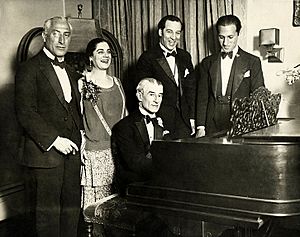
As Beethoven's career ended, the fortepiano changed into something more like the modern piano. Modern pianos were widely used by the late 1800s. They had more keys, adding lower bass notes and higher treble notes. Factories started making many upright pianos. This made them cheaper for more middle-class people. Pianos appeared in music halls and pubs in the 1800s. They provided entertainment with a solo pianist or a small dance band.
In the 1800s, American musicians, especially African-American composers, created new music styles for the piano. Ragtime music, made popular by composers like Scott Joplin, reached many people by 1900. Jazz piano quickly became popular after ragtime. New techniques and rhythms were invented for the piano. These included ostinato for boogie-woogie. George Gershwin's Rhapsody in Blue mixed American jazz piano with orchestra sounds. Comping, a way to play piano while a jazz singer sings, was shown by Duke Ellington. Honky-tonk music, another piano style, also became popular.
Later, Bebop techniques grew from jazz. Leading composer-pianists included Thelonious Monk and Bud Powell. In the late 1900s, Bill Evans combined classical techniques with his jazz experiments. In the 1970s, Herbie Hancock became famous for mixing jazz with newer urban music styles like jazz-funk and jazz-rock.
Pianos have also been important in rock and roll and rock music. Famous players include Jerry Lee Lewis, Little Richard, Elton John, Billy Joel, and Tori Amos. Modernist composers like John Cage and Philip Glass also wrote for the modern grand piano.
Interesting Piano Facts
- The piano was invented in the early 1700s. However, it took about 50 years for it to become popular.
- At first, the instrument was called the "fortepiano." This means "loud-soft" in Italian. It got this name because you could play it loudly or softly. Later, the name changed to "pianoforte."
- Early pianos had strings attached to a wooden frame. They were not very heavy, strong, or loud. So, they couldn't be heard well in a big concert hall.
- In some languages, like Russian, "fortepiano" is still the normal word for a piano.
- In 1768, Johann Christian Bach was the first person to play the piano in public at a concert in London.
Images for kids
-
1720 fortepiano by Italian maker Bartolomeo Cristofori, the world's oldest surviving piano, Metropolitan Museum of Art, New York City
-
Duplex scaling of an 1883 Steinway Model 'A'. From lower left to upper right: main sounding length of strings, treble bridge, duplex string length, duplex bar (nickel-plated bar parallel to bridge), hitchpins, plate strut with bearing bolt, plate hole
-
Cast iron plate of a grand piano
-
The piano was the centrepiece of social life in the 19th-century upper-middle-class home (Moritz von Schwind, 1868). The man at the piano is composer Franz Schubert (1797–1828).
See also
 In Spanish: Piano para niños
In Spanish: Piano para niños





